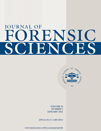Sexual Dimorphism of Anterior Sacral Curvature
Abstract
Abstract: This study assesses the predictive value of anterior sacral curvature for sex estimation from skeletonized remains. Sacra from a sample of 125 American adults of known age and sex were examined. Nine measurements describing anterior sacral curvature were used in the analysis. Statistical treatment of the data included univariate statistics and discriminant function analysis for sex classification. A bootstrap validation method was employed to assess the classification error rates. Sacral curvature was significantly greater in men than in women at the level of the S2–S3 and S3–S4 articulations (p < 0.05). Correct classification estimates for the discriminant function range from 66–72%. Although sexually dimorphic, metric observations of sacral curvature are not as reliable at predicting sex as other skeletal elements. Anterior sacral curvature should only be used for sex estimation in the absence of other, more reliable, indicators.




